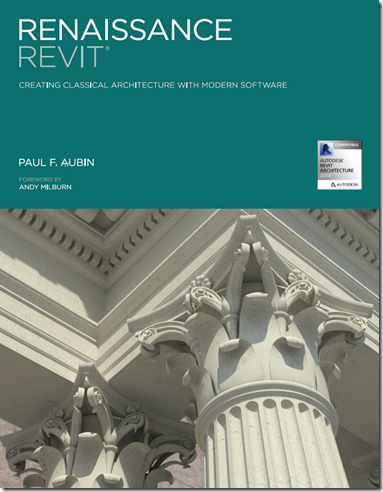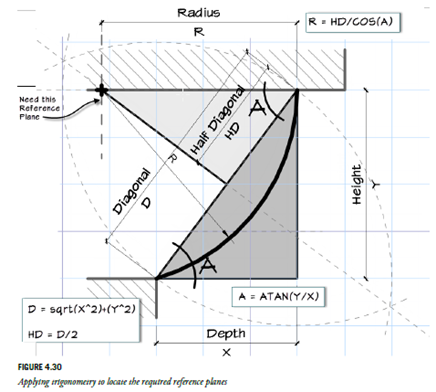 How do you succeed in becoming a Revit master? This is a question I often get asked. Also, I lose track of how many people I hear say, ahhhh you can’t do that in Revit, that is probably less relevant these days, as Revit is matured but you often still hear it. I would say that I am knowledgeable in the technology of Revit, with regards to its implementation and deployment, neither the less I wouldn’t say I know ever little button & detail of the tool inside & out & backwards. But from a visual perspective I know where things are. Yet how do you go from being a good competent user to an awesome one? There are plenty of books on the market which teach the basics, but very few that really accelerate your knowledge to super user level. Neither the less Paul Aubin sent me a link to his new book, eloquently named Revit Renaissance; Creating Classical Architecture with Modern Software. The book is squarely aimed at the intermediate / power user; or people who are looking to push their skills to the next level. Are most users creating Renaissance architecture? Maybe? Probably not? But don’t be put off by the name, it’s all about technical process. Paul does a marvellous job of taking a 21st technology and using it to create classical forms, in many ways the building blocks of today’s modern architecture. It drives you into thinking about creating geometry, proportion and scale. All the key components in what I believe deliver good architectural design. As mentioned by Andy Milburn in the books forward, Revit is today’s Rotring pen. At times I feel we have become so obsessed with the term BIM, that we are lost in the digital soup. The Revit technology is really a communication tool which aids you in the development of information. That information can be visualisations, views (digital drawings), assembly diagrams, quantities, you name it. But it should be noted that Revit isn’t BIM, it’s a tool to assist you in creating a model which you can do lots of “stuff” with.
How do you succeed in becoming a Revit master? This is a question I often get asked. Also, I lose track of how many people I hear say, ahhhh you can’t do that in Revit, that is probably less relevant these days, as Revit is matured but you often still hear it. I would say that I am knowledgeable in the technology of Revit, with regards to its implementation and deployment, neither the less I wouldn’t say I know ever little button & detail of the tool inside & out & backwards. But from a visual perspective I know where things are. Yet how do you go from being a good competent user to an awesome one? There are plenty of books on the market which teach the basics, but very few that really accelerate your knowledge to super user level. Neither the less Paul Aubin sent me a link to his new book, eloquently named Revit Renaissance; Creating Classical Architecture with Modern Software. The book is squarely aimed at the intermediate / power user; or people who are looking to push their skills to the next level. Are most users creating Renaissance architecture? Maybe? Probably not? But don’t be put off by the name, it’s all about technical process. Paul does a marvellous job of taking a 21st technology and using it to create classical forms, in many ways the building blocks of today’s modern architecture. It drives you into thinking about creating geometry, proportion and scale. All the key components in what I believe deliver good architectural design. As mentioned by Andy Milburn in the books forward, Revit is today’s Rotring pen. At times I feel we have become so obsessed with the term BIM, that we are lost in the digital soup. The Revit technology is really a communication tool which aids you in the development of information. That information can be visualisations, views (digital drawings), assembly diagrams, quantities, you name it. But it should be noted that Revit isn’t BIM, it’s a tool to assist you in creating a model which you can do lots of “stuff” with.
 Somewhere in my loft I have a huge leather covered architectural / joinery book which dates back to the 1900’s; has printed hand drawn diagrams of architectural order, joinery detailing, classical building assembly. My parents actually found the book in their garage when they moved into a house in the 1980’s. It has amazing architectural setting out plans for buildings like St. Pauls in London. It’s hardly a coffee table book, it’s dirty, smelly & covered in tea stains & it also weighs a ton, but there is something inherently lovely about the book and the contents included. I’m no architect, my background is an architectural technician, but the information included in that book is priceless. Whilst the principles of what we now call BIM are made up of 1’s & 0’s, back then, this was BIM. So with this in mind, Paul’s Book looks to recapture this concept & turn it on its head for the digital generation. Even if you don’t create classical architecture, the techniques, concepts and processes will be relevant to any style of architecture. In fact that’s an interesting point & relates to the learning experience. Taking complex subjects and applying it something which you might not see as relevant to your day to day business, then twisting it to make it work for you is a learning process, I see as very valuable. Spoon feeding is not how we should learn in my humble opinion.
Somewhere in my loft I have a huge leather covered architectural / joinery book which dates back to the 1900’s; has printed hand drawn diagrams of architectural order, joinery detailing, classical building assembly. My parents actually found the book in their garage when they moved into a house in the 1980’s. It has amazing architectural setting out plans for buildings like St. Pauls in London. It’s hardly a coffee table book, it’s dirty, smelly & covered in tea stains & it also weighs a ton, but there is something inherently lovely about the book and the contents included. I’m no architect, my background is an architectural technician, but the information included in that book is priceless. Whilst the principles of what we now call BIM are made up of 1’s & 0’s, back then, this was BIM. So with this in mind, Paul’s Book looks to recapture this concept & turn it on its head for the digital generation. Even if you don’t create classical architecture, the techniques, concepts and processes will be relevant to any style of architecture. In fact that’s an interesting point & relates to the learning experience. Taking complex subjects and applying it something which you might not see as relevant to your day to day business, then twisting it to make it work for you is a learning process, I see as very valuable. Spoon feeding is not how we should learn in my humble opinion.
 The book covers many aspects of the family editor which you might need from form making, nesting families, complex parameters and beyond. I would challenge anybody who would suggest they wouldn’t learn something from this book. Oh did I mention that non-other than Mr Aaron Maller was the technical editor! The explanation & attention to detail is what all technical books should be about, I would highly recommend it if you want to challenge your abilities & become a Revit master. For more details go to
The book covers many aspects of the family editor which you might need from form making, nesting families, complex parameters and beyond. I would challenge anybody who would suggest they wouldn’t learn something from this book. Oh did I mention that non-other than Mr Aaron Maller was the technical editor! The explanation & attention to detail is what all technical books should be about, I would highly recommend it if you want to challenge your abilities & become a Revit master. For more details go to
http://paulaubin.com/books/renaissance-revit/
 Hey, got a heads up from my old CASE buddies the other day with regards to the BIM Hackathon they will be hosting on the 3rd December, 2013 on the first day of Autodesk University (scarily enough that’s my birthday! hint hint!). So what is a BIM Hackathon you may ask? Well in essence its described as the following….
Hey, got a heads up from my old CASE buddies the other day with regards to the BIM Hackathon they will be hosting on the 3rd December, 2013 on the first day of Autodesk University (scarily enough that’s my birthday! hint hint!). So what is a BIM Hackathon you may ask? Well in essence its described as the following….

